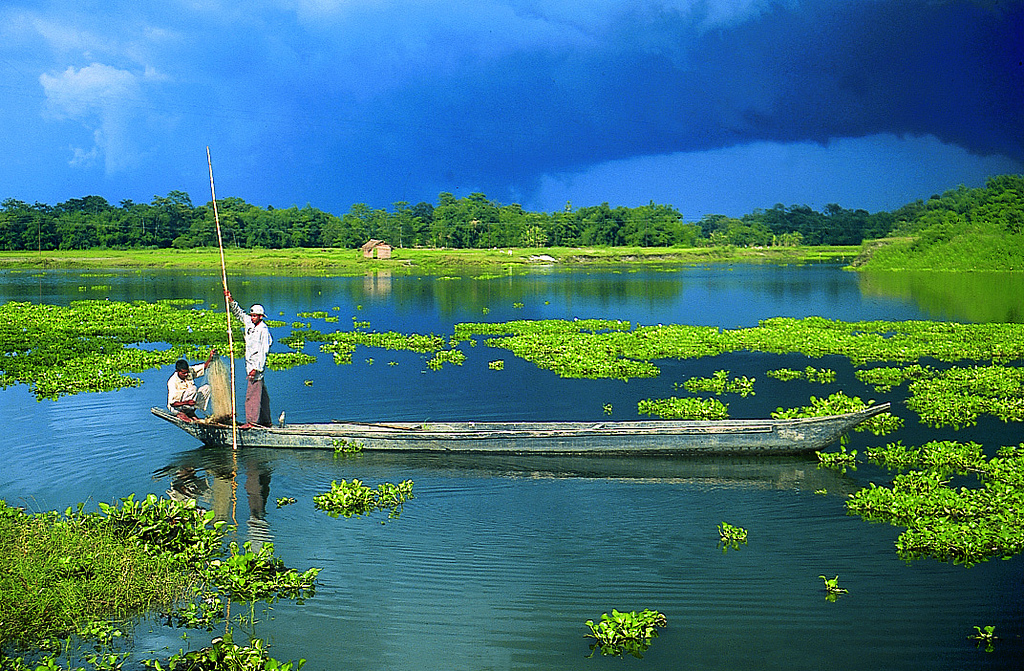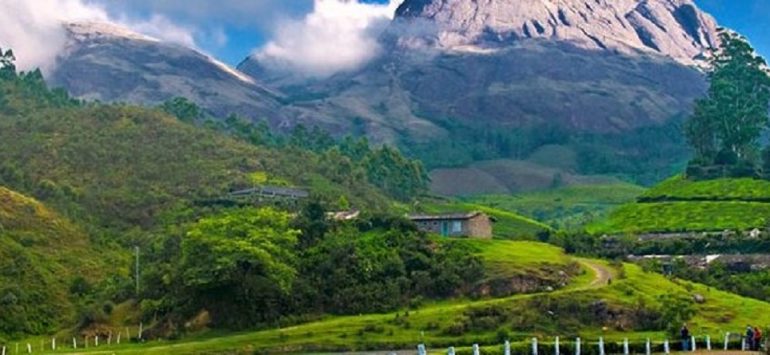
Majuli Island, nestled in the mighty Brahmaputra River in the Indian state of Assam, holds the distinction of being the world’s largest inland river island. Positioned between the districts of Jorhat and the Subansiri River, this unique island spans an area that fluctuates between 350 and 880 square kilometers, though it is gradually shrinking due to relentless riverine erosion. Recognizing its cultural and ecological significance, Majuli was officially declared India’s first island district in 2016, marking a milestone in the country’s administrative history.
The island is home to a rich tapestry of ethnic and tribal communities, including the Mising, Deori, and Sonowal Kachari people. These indigenous groups have coexisted peacefully for centuries, contributing to Majuli’s vibrant and diverse cultural landscape. One of the most distinguishing features of Majuli is its deep connection to the Assamese neo-Vaishnavite movement, a reformist sect of Hinduism founded by the 15th-century saint and social reformer Srimanta Sankardeva. The island emerged as a stronghold of this movement, which promotes egalitarian values, devotion to Lord Vishnu, and the use of art, music, and drama as forms of religious expression.
Majuli is particularly renowned for its Satras—monastic institutions that serve as spiritual, cultural, and educational centers. There are between 21 to 44 active Satras on the island, including prominent ones like Auniati Satra, Kamalabari Satra, Dakhinpat Satra, and Garmur Satra. These Satras are not merely places of worship; they are living museums of traditional Assamese art forms. They preserve and teach devotional dance (Sattriya, now one of India’s classical dance forms), music, manuscript painting, and the intricately crafted mask-making tradition used in Bhaona, a form of ritualistic theatre. The mask-making Satra at Samaguri is especially famous, and its master artist, Hem Chandra Goswami, was conferred the Padma Shri for his efforts in reviving this heritage.
Majuli remains a rare and soulful confluence of nature, spirituality, and heritage. Despite facing environmental threats, especially from erosion and flooding, the island continues to be a beacon of Assamese identity and resilience. Its unique cultural fabric and breathtaking natural setting make it one of the most important centers of intangible cultural heritage in India.
Culture & Heritage of Majuli Island
Satras – Monastic and Cultural Institutions
1. Auniati Satra:
Known for its rich collection of ancient artifacts, Assamese utensils, and literature. It plays a major role in the preservation of Sattriya dance and music.
2. Dakhinpat Satra:
Famous for its grand celebration of Raas Mahotsav, this Satra draws pilgrims and tourists alike for its religious and cultural significance.
3. Kamalabari Satra:
A major center for classical Sattriya dance and music, this Satra has contributed immensely to Assamese literature, art, and philosophy.
4. Garmur Satra:
A liberal Satra known for its inclusive approach; women are allowed to enter and participate in rituals—unlike many other Satras.
5. Tengapania Satra:
Set amidst scenic surroundings, this Satra is an architectural gem and a spiritual retreat for followers of the neo-Vaishnavite tradition.
Mask-making Tradition at Samaguri Satra
- This Satra is globally acclaimed for its unique mask-making art, used in Bhaona (traditional Vaishnavite theatre).
- The masks are made using eco-friendly materials like bamboo, clay, cloth, and cow dung, and are painted in bright colors representing gods, demons, and mythological figures.
- These masks are GI (Geographical Indication) tagged, giving them cultural and commercial recognition.
- Hem Chandra Goswami, a master artist from this Satra, was honored with the Padma Shri for his remarkable contribution to preserving and promoting this traditional craft.
Festivals – Celebrating Faith, Art, and Community
1. Raas Mahotsav (November, during the full moon): The most famous festival in Majuli, depicting episodes from Lord Krishna’s life through drama, dance, and music. A major attraction for cultural tourists.
2. Ali-Aye-Ligang (February): Celebrated by the Mising tribe, marking the beginning of the sowing season. Features traditional songs, dances like Gumraag, and indigenous food and rice beer.
3. Bihu: Like the rest of Assam, Majuli celebrates the three Bihus—Rongali, Bhogali, and Kongali—with community feasts, games, folk songs, and dances.
4. Paal Naam: A 7–10 day spiritual gathering involving continuous singing of devotional songs (Naam-Prasanga) and collective prayer at the Satras. It embodies the deep religious devotion of the neo-Vaishnavite followers.
Things to do at Majuli Island
1. Explore the Island by Bicycle
- Rent a bicycle (approx. ₹100–₹150/day) and roam through lush green paddy fields, bamboo groves, and tribal villages.
- The flat terrain and quiet lanes make cycling a peaceful and eco-friendly way to explore.
2. Visit the Historic Satras
- Auniati, Kamalabari, Dakhinpat, Garmur, Samaguri Satras offer spiritual retreats and vibrant cultural experiences.
- Watch Sattriya dance performances, spiritual chanting (Naam-Prasanga), and traditional music sessions.
3. Witness Mask-Making at Samaguri Satra
- Interact with artists creating handmade traditional masks used in Bhaona performances.
- Learn about the process using bamboo, clay, and fabric.
- Buy authentic, GI-tagged masks as souvenirs.
4. Bird Watching and Nature Walks
- Visit Chakoli Beel and Talmari wetlands, especially during winter, to spot migratory birds like pelicans, herons, and Siberian cranes.
- Ideal for photographers and nature lovers.
5. Attend Local Festivals
- Raas Mahotsav (November): Don’t miss the dramatic storytelling of Krishna’s life through dance and drama.
- Ali-Aye-Ligang (February): Celebrate with the Mising tribe, enjoy rice beer, dance, and traditional food.
- Paal Naam and Bihu offer deep insight into local religious and agricultural life.
6. Experience Village Life
- Take a village tour to Mising tribal settlements.
- Stay in a traditional bamboo stilt house.
- Engage in weaving, pottery, and organic farming.
7. Try Local Cuisine
- Taste ethnic dishes like apong (rice beer), smoked pork, bamboo shoot curry, and rice cakes.
- Join a homestay that offers home-cooked meals for an authentic Assamese experience.
8. Enjoy Boat Rides on the Brahmaputra
- Hire a canoe or join a group boat ride.
- Best during sunrise or sunset—calm waters, golden skies, and distant mountain silhouettes make it unforgettable.
9. Visit Salmora Village for Traditional Pottery
- Discover the wheel-less pottery technique—shaped by hand and fired in open pits.
- Interact with potters and even try your hand at making a pot.
10. Meditate and Relax
- Find a quiet corner by the riverbank or within a Satra courtyard.
- The serene and spiritual atmosphere of Majuli is ideal for reflection, reading, or yoga.
Travel Tips for Visiting Majuli Island
1. Best Time to Visit
- October to March is ideal: Pleasant weather, clear skies, and festival season (especially Raas Mahotsav in November).
- Avoid June to September (monsoon): The island is prone to flooding and erosion, which can disrupt transport and sightseeing.
2. How to Reach
- Nearest City: Jorhat, Assam.
- From Jorhat:
- Travel to Nimati Ghat (~14 km from Jorhat).
- Take a government or private ferry to Majuli (usually 1–1.5 hours).
- Ferry services run 8:00 AM to 4:00 PM (may vary by season).
Note: Ferry services are limited or canceled during bad weather or floods.
3. Where to Stay
- Homestays & Eco-resorts: Cozy bamboo cottages and riverside lodges offer an immersive experience.
- Satra Guest Houses: Some Satras like Auniati or Kamalabari provide basic accommodations.
- Book early during peak season (especially during festivals).
- Limited luxury options, so embrace the rustic charm.
4. Cash & Connectivity
- Carry enough cash: ATMs are very limited and may not function reliably.
- Mobile networks: Coverage is spotty, especially in remote areas.
- BSNL and Jio work better than others.
5. Local Transport
- Cycles and scooters are best for getting around.
- Bicycle rental: ₹100–₹150/day.
- No public transport within the island—use rickshaws, hired scooters, or walk.
6. Food & Water
- Try local tribal cuisine (rice, pork, bamboo shoots, apong rice beer).
- Vegetarian meals are available at Satras or family-run eateries.
- Drink only bottled or filtered water to avoid waterborne illness.
7. Cultural Etiquette
- Dress modestly, especially when visiting Satras.
- Remove footwear before entering prayer halls or monasteries.
- Ask before taking photos of people, rituals, or inside religious spaces.
8. What to Pack
- Light cotton clothes (for day) + a light jacket (for cool mornings/evenings).
- Raincoat or umbrella if visiting in the shoulder seasons.
- Torch, insect repellent, power bank, and basic medicines.
9. Be Prepared for Limited Infrastructure
- Roads can be bumpy and dusty.
- Power cuts are common—carry a torch or solar light.
- Medical facilities are basic—carry essentials.
10. Travel Responsibly
- Respect the environment: No littering, avoid plastic.
- Support local artisans by purchasing authentic crafts like masks or pottery.
- Be kind and curious—locals are welcoming and proud of their culture.
Why Majuli deserves a spot on your bucket list
- A living cultural landscape where age-old Vaishnavite tradition thrives in real-time.
- A scenic riverine paradise that’s ideal for boat rides, birdwatching, cycling, and capturing dramatic sunsets.
- A global destination for authentic tribal arts, including mask-making and pottery.
- Experience the complexities of eco‑tourism—witness both its fragile environment and resilient local communities.
Places to explore near Majuli Island
1. Jorhat (Approx. 14 km from Nimati Ghat)
Gateway to Majuli and a charming town with colonial heritage, tea gardens, and cultural sites.
Top Attractions:
- Tocklai Tea Research Centre – Learn about Assam tea cultivation.
- Burigosain Devalay – A revered Shiva temple.
- Cinnamara Tea Estate – One of the oldest tea estates in Assam.
- Gymkhana Club – Historic British-era club (est. 1876).
2. Kaziranga National Park (Approx. 110 km / 3–4 hrs)
A UNESCO World Heritage Site famous for the one-horned rhinoceros, elephants, tigers, and birdlife.
Best Time: Nov–April (Safari season)
Activities: Jeep/elephant safari, birdwatching, nature trails.
3. Sivasagar (Approx. 80 km from Jorhat)
Once the capital of the Ahom Kingdom, rich in Ahom-era architecture and history.
Must-See:
- Rang Ghar – Asia’s oldest amphitheatre.
- Talatal Ghar – Underground palace with tunnels.
- Siva Dol – One of the tallest Shiva temples in India.
- Joy Sagar Tank – A massive water tank with scenic temples.
4. Dhemaji & Subansiri River Region
- Located northeast of Majuli, across the Subansiri River.
- Explore tribal culture (especially the Mising and Bodo communities).
- Enjoy offbeat countryside, bamboo houses, and rural traditions.
5. Dhekiakhowa Bornamghar (Near Jorhat)
- One of the oldest Namghars (Vaishnavite prayer halls) in Assam.
- Famous for its perpetually burning lamp lit in 1528 A.D.
- Peaceful spiritual atmosphere with local folklore.
6. Nimati Ghat
- The ferry terminal to Majuli, but also a scenic riverfront spot.
- Visit in the morning for foggy views over the Brahmaputra or at sunset.
- Hollongapar Gibbon Wildlife Sanctuary (Approx. 20 km from Jorhat)
- A dense evergreen forest that is home to India’s only ape species—the Hoolock Gibbon.
- Also hosts macaques, hornbills, and jungle cats.
- Ideal for trekking and wildlife photography.


